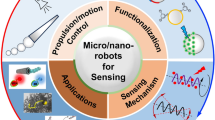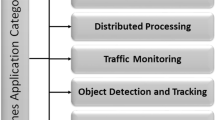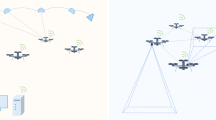Abstract
In swarm robotics, communication among the robots is essential. Inspired by biological swarms using pheromones, we propose the use of chemical compounds to realize group foraging behavior in robot swarms. We designed a fully autonomous robot, and then created a swarm using ethanol as the trail pheromone allowing the robots to communicate with one another indirectly via pheromone trails. Our group recruitment and cooperative transport algorithms provide the robots with the required swarm behavior. We conducted both simulations and experiments with real robot swarms, and analyzed the data statistically to investigate any changes caused by pheromone communication in the performance of the swarm in solving foraging recruitment and cooperative transport tasks. The results show that the robots can communicate using pheromone trails, and that the improvement due to pheromone communication may be non-linear, depending on the size of the robot swarm.


















Similar content being viewed by others
Notes
We needed 5 min duration time of pheromone trail, and found that the robot lays down a few times in preliminary experiment. Therefore, we used 100v/v% ethanol which does not require sensitive micro-pump setting.
References
Balch, T. (1999). The impact of diversity on performance in multi-robot foraging. In Proceedings of the Third Annual Conference on Autonomous Agents, ACM (pp. 92–99).
Balch, T., & Arkin, R. (1994). Communication in reactive multiagent robotic systems. Autonomous Robots, 1(1), 27–52.
Beckers, R., Holland, O., & Deneubourg, J. L. (1994). From local actions to global tasks: Stigmergy and collective robotics. In R. Brooks & P. Maes (Eds.), Artificial life IV. Cambridge, MA: MIT Press.
Donald, B., Jennings, J., & Rus, D. (1994) Analyzing teams of cooperating mobile robots. In Proceedings of the 1994 IEEE International Conference on Robotics and Automation, IEEE (pp. 1896–1903).
Dorigo, M., Maniezzo, V., & Colorni, A. (1996). Ant system: optimization by a colony of cooperating agents. IEEE Transactions on Systems, Man, and Cybernetics, Part B: Cybernetics, 26(1), 29–41.
Fujisawa, R., Imamura, H., Hashimoto, T., & Matsuno, F. (2007) Swarm intelligence of multi-robot using pheromone trail. In Proceedings of the 2nd Internal Symposium on Mobiligence (pp. 203–206).
Fujisawa, R., Dobata, S., Kubota, D., Imamura, H., & Matsuno, F. (2008a). Dependency by concentration of pheromone trail for multiple robots. In Proceedings of Sixth International Conference on Ant Colony Optimization and Swarm Intelligence, LNCS 5217, Springer (pp. 283–290).
Fujisawa, R., Imamura, H., Hashimoto, T., & Matsuno, F. (2008b). Communication using pheromone field for multiple robots. In Proceedings of the IEEE/RSJ 2008 International Conference on Intelligent Robots and Systems, IEEE (pp. 1391–1396).
Fujisawa, R., Imamura, H., Hashimoto, T., & Matsuno, F. (2009). Development of multi-robots communicating by pheromone trail. IPSJ Transactions on Mathematical Modeling and its Applications, 2(2), 81–90. In Japanese.
Fujisawa, R., Imamura, H., & Matsuno, F. (2010) Cooperative transportation by swarm robots using pheromone communication. In Proceedings of the 10th International Symposium on Distributed Autonomous Robotics Systems (DARS2010), Springer.
Fujisawa, R., Dobata, S., Sasaki, Y., Takisawa, R., & Matsuno, F. (2012). Collision-induced “priority rule” governs efficiency of pheromone-communicating swarm robots. In Proceedings of Eighth International Conference on Ant Colony Optimization and Swarm Intelligence, LNCS 7461, Springer (pp. 228–235).
Garnier, S., Tâche, F., Combe, M., Grimal, A., & Theraulaz, G. (2007). Alice in pheromone land: An experimental setup for the study of ant-like robots. In: Swarm Intelligence Symposium, SIS 2007, IEEE (pp. 37–44).
Grassé, P. P. (1959). La reconstruction du nid et les coordinations inter-individuelles chez Bellicositermes Natalensis et Cubitermes sp. La théorie de la stigmergie: Essaid’interpretation du comportement de termites constructeurs. Insectes Sociaux, 6(1), 41–80.
Hamann, H., & Wörn, H. (2007). An analytical and spatial model of foraging in a swarm of robots. In E. Şahin, W. M. Spears & A.F.T. Winfield (Eds.), Swarm Robotics, LNCS 4433 (pp. 43–55). Berlin: Springer.
Hangartner, W. (1967). Spezifität und Inaktivierung des Spurpheromons von Lasium fulginosus Latr. und Orientierung der Arbeiterinnen im Duftfeld. Zeitschrift für Vergleichende Physiologie, 57, 103–136.
Hayes, A., Martinoli, A., & Goodman, R. (2002). Distributed odor source localization. IEEE Sensors Journal, 2(3), 260–271.
Hölldobler, B., & Wilson, E. (1990). The ants. Cambridge, MA: The Belknap Press of Harvard University Press.
Ichikawa, S., & Hara, F. (1996). Experimental characteristics of multiple-robots behaviors in communication network expansion and object-fetching. In Proceedings of the 3rd International Symposium Distributed Autonomous Robotic System, Springer (pp. 183–194).
Krieger, M., Billeter, J., & Keller, L. (2000). Ant-like task allocation and recruitment in cooperative robots. Nature, 406(6799), 992–995.
Kube, C., & Zhang, H. (1993). Collective robotics: From social insects to robots. Adaptive Behavior, 2(2), 189–218.
Kube, C., & Bonabeau, E. (2000). Cooperative transport by ants and robots. Robotics and Autonomous Systems, 30(1), 85–101.
Kurabayashi, D., & Asama, H. (2000). Knowledge sharing and cooperation of autonomous robots by intelligent data carrier system. In Proceedings of the 2000 IEEE International Conference on Robotics and Automation, IEEE (Vol. 1, pp. 464–469).
Kurumatani, K. (2000). Macro-model generation for emergent cooperative behaviors in ant colony’s foraging (1)—a simple model case. Journal of the Japanese Society for Artificial Intelligence, 15(5), 829–837. (In Japanese).
Matarić, M., Nilsson, M., & Simsarin, K. (1995). Cooperative multi-robot box-pushing. In IEEE/RSJ International Conference on Intelligent Robots and Systems 95’. Human Robot Interaction and Cooperative Robots’, Proceedings of the 1995, IEEE (Vol. 3, pp. 556–561).
Nakamichi, Y., & Arita, T. (2004). An evolutionary simulation of the origin of pheromone communication. In ISPJ Symposium Series, Information Processing Society of Japan (Vol. 2004, pp. 51–58).
Nouyan, S., Campo, A., & Dorigo, M. (2008). Path formation in a robot swarm. Swarm Intelligence, 2(1), 1–23.
Nouyan, S., Groß, R., Bonani, M., Mondada, F., & Dorigo, M. (2009). Teamwork in self-organized robot colonies. IEEE Transactions on Evolutionary Computation, 13(4), 695–711.
Purnamadjaja, A. H., & Russell, R. A. (2007). Guiding robots’ behaviors using pheromone communication. Autonomous Robots, 23(2), 113–130.
R Core Team: R. (2013). A Language and Environment for Statistical Computing. R Foundation for Statistical Computing, Vienna, Austria. Retrieved August 20, 2014 from http://www.R-project.org/.
Russell, R. (1997). Heat trails as short-lived navigational markers for mobile robots. In Proceedings of the 1997 IEEE International Conference on Robotics and Automation, IEEE (Vol. 4, pp. 3534–3539).
Steels, L. (1990). Cooperation between distributed agents through self-organisation. In Proceedings of the 1990 IEEE International Conference on Intelligent Robots and Systems, IEEE (pp. 8–14).
Sugawara, K., Kazama, T., & Watanabe, T. (2004). Foraging behavior of interacting robots with virtual pheromone. In Proceedings of the IEEE/RSJ International Conference on Intelligent Robots and Systems (IROS2004), IEEE (Vol. 3, pp. 3074–3079).
Acknowledgments
We wish to thank Hikaru Imamura, who assisted with the experiments of attraction and cooperative transport, and Yuki Fujisawa, who despite being pregnant, tolerated the late return of her husband on numerous occasions.
Author information
Authors and Affiliations
Corresponding author
Rights and permissions
About this article
Cite this article
Fujisawa, R., Dobata, S., Sugawara, K. et al. Designing pheromone communication in swarm robotics: Group foraging behavior mediated by chemical substance. Swarm Intell 8, 227–246 (2014). https://doi.org/10.1007/s11721-014-0097-z
Received:
Accepted:
Published:
Issue Date:
DOI: https://doi.org/10.1007/s11721-014-0097-z




